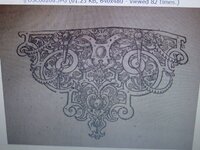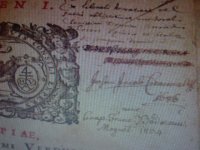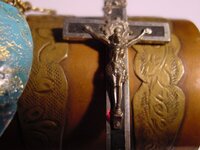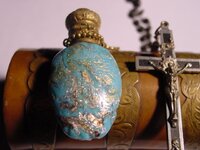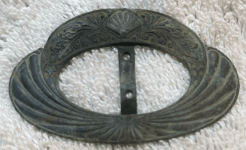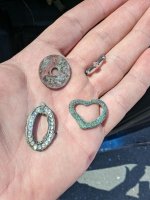maybe wrong forum, , but I dont know where else you hang out,your friend, gd
You are using an out of date browser. It may not display this or other websites correctly.
You should upgrade or use an alternative browser.
You should upgrade or use an alternative browser.
Mr. Lamar,can you help in decifering religous content,thanks
- Thread starter ghostdog
- Start date
lamar
Bronze Member
- Aug 30, 2004
- 1,341
- 46
Dear ghostdog;
The first photo is of a woodcut print. The scrollwork and two gargoyles were popular garnish themes for officious letters of correspondence. I would place the date of the print at appreoximately the early to mid reformation period.
The second photo needs to be more clear and the fine details enhanced. Also two photos, one from further away and one close up would be highly desirable. Also, if possible, could you please circle the specific areas which you would liek for me to review? Thank you very much, my friend.
Your friend;
LAMAR
The first photo is of a woodcut print. The scrollwork and two gargoyles were popular garnish themes for officious letters of correspondence. I would place the date of the print at appreoximately the early to mid reformation period.
The second photo needs to be more clear and the fine details enhanced. Also two photos, one from further away and one close up would be highly desirable. Also, if possible, could you please circle the specific areas which you would liek for me to review? Thank you very much, my friend.
Your friend;
LAMAR
- Thread starter
- #3
Thanks Larmar, I will try and post more photos latter in the week, meanwhile here are some recent finds I made while back tracking a old Spanish trail looking for their campgrounds,somewhere on the planet. Maybe you could date the cross, other 2 items might be a scent bottle,copper box. gd
Attachments
lamar
Bronze Member
- Aug 30, 2004
- 1,341
- 46
Dear ghostdog;
The crucifix was part of a rosary and is from the modern era , very inexpensively produced and manufactured throughout the 20th century. The most likely places of origin would be Italy, Poland, Hungary, and Romania, in that order. The skull and crossbones motif at the bottom of the crucifix was very popular until it gradually starting disappearing after Vatican II. Also, the small scroll with the letters INRI at the top of the crucifix are no longer popular in modern Christian themes. The INRI scroll is known as a *titulus* and the initials stand for the Latin acronym"IESVS·NAZARENVS·REX·IVDÆORVM". In Eglish it means "JESUS OF NAZARETH, KING OF THE JEWS" which was written on a plank and placed above Christs' head by the Roman soldiers as a form of mockery. Accounts of this may be found in the Gospels of Luke, John, Matthew and Mark, although the wording from each Gospel varies slightly. The skull and crossbones, typically affixed below the corpus (body) represents Mt. Golgotha, the place where Jesus was crucified. Crucifixes of this type were very common items among Roman Catholics and this style remains popular in Latin American countries. In fact, the crucifix in the photograph looks exactly like mine.
The copper container in the photograph is of Mexican manufacture, date of origin presently unknown. From the design, style and manufacture, I would say that it could have been made as early as the 1800s, however this is purely an estimate as many copper and silversmiths in Mexico and Central America continue to use the old methods and textures in their handicrafts.
I am unsure of the bottle as the photograph does not show a lot of detail, but again, I would say that it was most probably a perfumery bottle, based on design, most especially the neck and cap enclosure.
Your friend;
LAMAR
The crucifix was part of a rosary and is from the modern era , very inexpensively produced and manufactured throughout the 20th century. The most likely places of origin would be Italy, Poland, Hungary, and Romania, in that order. The skull and crossbones motif at the bottom of the crucifix was very popular until it gradually starting disappearing after Vatican II. Also, the small scroll with the letters INRI at the top of the crucifix are no longer popular in modern Christian themes. The INRI scroll is known as a *titulus* and the initials stand for the Latin acronym"IESVS·NAZARENVS·REX·IVDÆORVM". In Eglish it means "JESUS OF NAZARETH, KING OF THE JEWS" which was written on a plank and placed above Christs' head by the Roman soldiers as a form of mockery. Accounts of this may be found in the Gospels of Luke, John, Matthew and Mark, although the wording from each Gospel varies slightly. The skull and crossbones, typically affixed below the corpus (body) represents Mt. Golgotha, the place where Jesus was crucified. Crucifixes of this type were very common items among Roman Catholics and this style remains popular in Latin American countries. In fact, the crucifix in the photograph looks exactly like mine.
The copper container in the photograph is of Mexican manufacture, date of origin presently unknown. From the design, style and manufacture, I would say that it could have been made as early as the 1800s, however this is purely an estimate as many copper and silversmiths in Mexico and Central America continue to use the old methods and textures in their handicrafts.
I am unsure of the bottle as the photograph does not show a lot of detail, but again, I would say that it was most probably a perfumery bottle, based on design, most especially the neck and cap enclosure.
Your friend;
LAMAR
Users who are viewing this thread
Total: 2 (members: 0, guests: 2)


